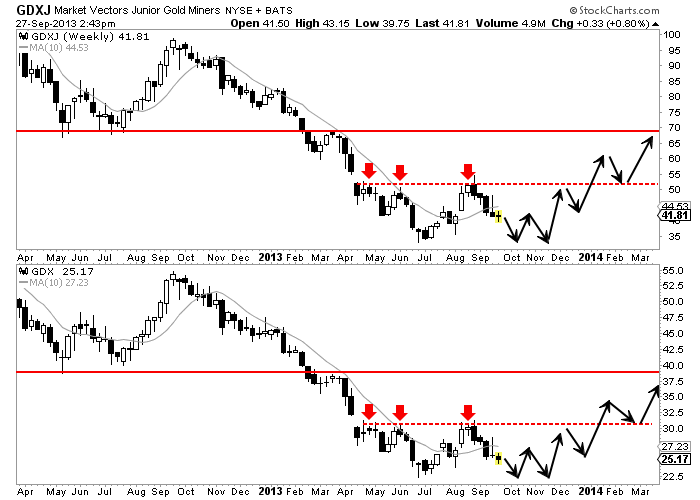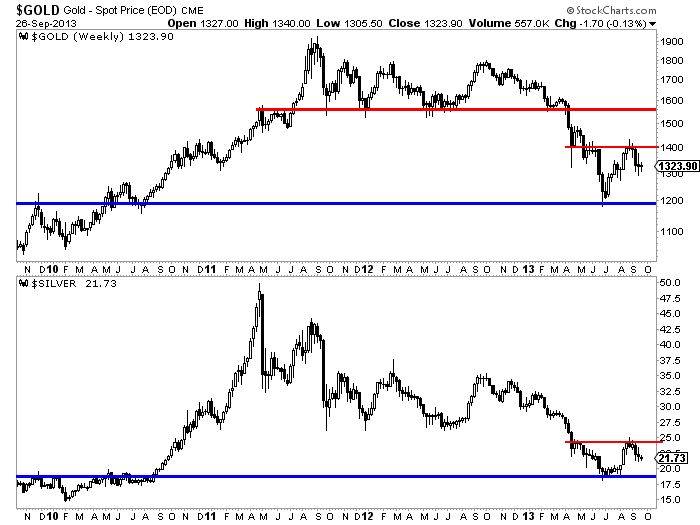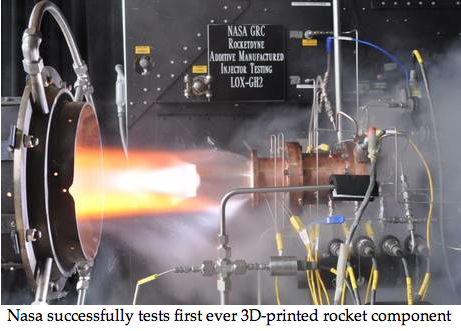Mike's Content
Revolutionary visions of our 3D printed future:
1. Rocket parts. NASA is working on the largest rocket ever constructed that is projected to take humans to Mars by 2030. Bypassing traditional processes for building rocket parts, which require welding of seams, creating a single seamless 3D printed piece means less chance for leakage. It also cuts down the cost of manufacturing by almost half. Recently, NASA tested 3D-printed rocket engine injectors in hot-fire tests, exposing them to extreme temperatures and pressures. They passed with flying colors.
2. Guns. Marc Goodman, in his 2012 TED Talk, pondered the effect that new technologies like 3D printing would have on crime. He proposed a scary scenario: cheap guns and bullets that can be printed in one’s own home. A year later, Defense Distributed founder Cody Wilson created and shot the first 3D printed handgun in May 2013. And up until a few months ago, blueprints were available to the public on his website.
3. Meat and leather. The US startup Modern Meadow is working on creating meat and leather products — without killing animals. Founder Andras Forgacs, who spoke on the TED Global 2013 stage, asked, “Animal products are just collections of tissues. So what if instead of starting with animals, we started with cells?” Using a stem-cell sample taken from a biopsy, the cell is cultured until it’s multiplied. Then this bioink that contains hundreds of live cells is printed, and the cells form living tissue. Forgacs is starting with leather, then moving on to meat.
4. Virtually any food. Can the technology of 3D printing be harnessed to tackle world hunger? Anjan Contractor, a mechanical engineer at Systems and Materials Research Corporation, is working on a prototype for a “universal food synthesizer.” It sounds like a crazy science fiction story: a 3D printer in each household with the ability to print healthy meals from powders, with a shelf life of at least 15 years. But it’s becoming a probable reality.
5. A house. Designer Alastair Parvain explores the idea of regular people being able to print and construct their own homes. In his TED Talk, he talks about WikiHouse, an open-source construction kit that’s a library of 3D models and cutting files that will allow anyone using a CNC machine and plywood, to “print” out the parts for their own house. Meanwhile in Amsterdam, construction of a 6-meter tall printer called the KamerMaker (Dutch for room-maker) has already begun for printing components of a house.
6. Liquid metal parts. At North Carolina State University, researchers developed a metal alloy that remains at a liquid state at room temperature. They then used a syringe to arrange the droplets into a vertical chain-like structure. The next step, now, is to create a 3D printer for the purpose of printing this liquid metal. If the technology is harnessed, it would allow for the creation of bendy electronics, and revolutionize the electronics manufacturing process.
7. Bionic ear and jaw bone. Right now, the potential for 3D printing in the medical sphere is incredible. Last year, an 83-year-old Belgian woman received the first 3D printed jaw bone, a transplant that was tailored specifically for her facial structure. A bionic ear was printed from a concoction of calf cells and hydrogel and antennae made from nanoparticles. The first version allowed hearing at a superhuman range, powerful enough to pick up radio waves.
8. High fashion. Designers are already experimenting with 3D-printed materials in creative and innovative ways. The cheaper cost of manufacturing would certainly have an impact on the current system of mass production. Silk is already being experimented with. MIT researchers have used 6,500 silkworms to 3D-print this ethereal silk dome-shaped pavilion covering.
9. A Moon base. Architecture firm Foster + Partners have paired with The European Space Agency to investigate the possibility of a 3D printed moon habitat. The material used in the printing process would be moon dust and soil that would be layered to form a building block, not unlike concrete. This method would save us from the challenge of transporting raw building materials.

 “A Primer on 3D Printing: How It Works” – Lisa Harouni
“A Primer on 3D Printing: How It Works” – Lisa Harouni
It is the dawn of the era of 3D printing. From artificial prosthetics to very real human kidneys to filigree skull sculptures – the number and variety of applications for this technology are growing, layer by printed layer. Combine this with the decreasing cost of owning a printer, as well as the cheaper cost of manufacturing in general, and it appears that 3D printers are here to stay.
….to read more Click HERE – and scroll down and click on the link “A Primer On 3D Printing” by Lisa Harouni or click directly here on “A Primer on 3D Printing” – Lisa Harouni
Check It Out
If you are already familiar with 3D printing scroll down further on the link above to David F Flanders’ excellent talk – “Why I have a 3D printer” or click directly here on “Why I have a 3D printer” – David F Flanders’


In our last editorial we pointed out how the gold stocks had veered off the recovery course. They fell well below the recovery template and fell below their 50-day moving averages. Furthermore, the positive “non-taper” news turned out to be the mother of all bull traps for traders. The market soared on presumably an epic amount of short covering. Yet that only served to be a selling opportunity for traders. That sequence of events only strengthened our view that the sector continues to be headed for a retest which could serve as the mother of all buying opportunities.
The weekly chart of GDXJ and GDX shows these markets sitting between strong support and strong resistance. At current prices, GDX has 12% downside to its daily closing low while GDXJ has 21% downside to its daily closing low. The silver stocks (SIL is not shown) also have 21% downside to their daily closing low. That is probably too much downside for a new low but it doesn’t rule out a retest.

The weekly charts for Gold and Silver show a similar picture. Gold rallied nearly $220 on a daily closing basis. However, it failed at $1400 which is now clear resistance. Similarly, Silver rallied from $18 to nearly $25. There is quite a bit of resistance at $24. We think its unlikely Gold and Silver break past $1400 and $25 anytime soon. We’d first anticipate a retest of the summer lows or at best weeks and weeks of back and forth of action.

The good news for precious metals bulls is this market remains in a bottoming process which should produce a turning point that is on par with those seen in 2000 and 2008. The bad news is we are already five months into this bottoming process and it can continue for several more months. We don’t see widespread news in the sector but it is possible that GDX makes a new low but not GDXJ. It’s possible Gold makes a new low but not Silver. Major divergences are common at major bottoms.
The gold and silver stocks have been in a two and a half year bear market and have shed anywhere from 65% to 78%. Silver has been in a two and a half year bear market and at one point shed nearly 65%. Gold has been in a two-year bear market and has shed 36%. Huge cyclical rebounds aren’t an immediate reaction to the scope of these types of declines. These markets are telling us that the worst is just about over with yet more time is needed for a base that will launch the next phase of this secular bull market. If you don’t believe the next phase is worth waiting for then consider the following. Following these major bottoms the mining stocks have rallied on average 60%-70% within five months. In the two-month rally this summer, SIL rebounded 55% while GDXJ rebounded 63% (both on a daily closing basis). Once this bottoming process moves to its final stages, many stocks will be primed for spectacular rebounds that could occur in weeks and months. Readers are advised to watch closely and spot the companies which show the most strength during this retest. If you’d be interested in our analysis on the companies poised to lead this new bull market, we invite you to learn more about our service.
Jordan Roy-Byrne, CMT
About The Daily Gold
Jordan Roy-Byrne, CMT (Trendsman) is a Chartered Market Technician and member of the Market Technicians Association.. He is the publisher and editor of TheDailyGold Premium, a publication which emphasizes market timing and stock selection for the sophisticated investor.
From 2010-2012 The Daily Gold Premium Model Portfolio was up 131% compared to GDX (+5%) and GDXJ (-11%). In 2012, the Model Portfolio was up 32%, making it arguably one of the top-performing gold/silver stock newsletters. Jordan’s work has been featured in CNBC, Barrons, Financial Times Alphaville, Kitco and Yahoo Finance. He is quoted regularly in Barrons. Jordan has been a speaker at PDAC, Cambridge House and Hard Assets conferences. Jordan earned a degree in General Studies from the University of Washington with a concentration in International Economic Development. He also lived and worked in Southeast Asia for 3 years in order to study economic development from an emerging market perspective. In his spare time he enjoys spending time with Mrs. Trendsman.
Contact: Jordan @ TheDailyGold.com

Live – Tomorrow at 10:15am Pacific
How to use ETFs in your portfolio













